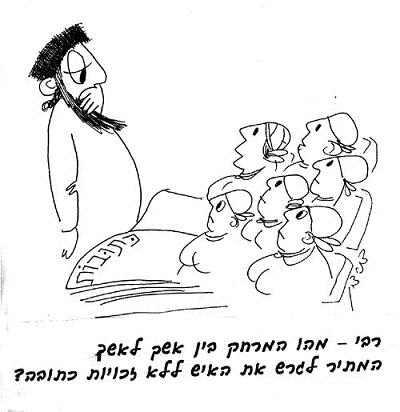
The early sages (Tanaaim) ruled that one who marries a woman and after the marriage finds defects which he could not have known of, like a defect in a covered part of her body or anything else he had no way to know, may divorce his wife without paying her for the rights granted by her marriage contract. The list of defects which a woman might have is taken from the list of defects which would cause a cohen to be ineligible to work in the Holy Temple. (The list is found in the Mishnah, Bechorot 6:7.)
A woman may have other defects which abrogate her rights: sweat, a mole, bad breath. The scholars asked: Isn’t a cohen who sweats or has bad breath also invalid to work in the Holy Temple? Answer: Continual sweat invalidates a cohen but not passing sweat; a woman loses her rights even for sweat of a passing nature. Another sage, Rabbi Ashi, explained that a cohen can temporarily remove his sweat or bad breath in order to work in the Holy Temple by showering or brushing his teeth and putting on cologne. But a women who is always with her husband cannot forever conceal the sweat or bad breath, so she is divorced without her rights according to the ketubah.
The scholars (Amoraim) clarify the type of mole which loses a woman her rights though it would not invalidate a cohen from his work in the Temple. If the mole has hairs, it also invalidates a cohen. If the mole is large — the sages defined this as the size of a coin — thought it has no hair it still invalidates the cohen. A small mole with no hair does not abrogate the woman’s rights, so what sort of mole abrogates her rights but does not invalidate the cohen from serving in the Holy Temple? Answer: The scholar Rabbi Yossi son of Rabbi Chananyah said it is a small hairless mole on the forehead. This sort of mole is obvious and makes a woman ugly. The scholars asked: If the mole is on the forehead the husband probably saw it before the wedding yet still married her, meaning that he agreed to marry her despite the defect. Another scholar, Rav Papa, answered: It is a small hairless mole at the edge of her hair, near the forehead — sometimes her head covering covers the mole and sometimes it does not . In this case she is divorced without her ketubah rights.
The scholars added to the list of defects which abrogate the woman’s rights: If she was bitten by a dog and scarred, if her voice is harsh and unpleasant to hear, and a defect which they described as “The space of a tefach between a woman’s breasts.” One of the scholars, Rav Acher son of Rava, understood that the space of a tefach (about 10 centimeters) between a woman’s breasts suits a woman. Another scholar, Rav Ashi, explained to him that this spacing is unsuitable and it is considered a defect which allows her to be divorced without rights. The scholars asked: How much space should be between a woman’s breasts to be considered suitable and lovely? Answer: The space of three fingers (about 6 centimeters). They added that a woman whose breasts are larger than other women’s is considered to have a defect which permits one to divorce her without rights. The scholars asked: What is meant by larger? Answer: A tefach (about 10 centimeters). The scholars asked: Is there any woman who has such large breasts? Answer: Yes. There was an incident involving an Arab woman who threw her breasts over her back and nursed her son.
(Babylonian Talmud, Tractate Ketubot 75a)
